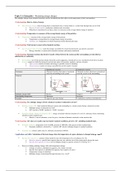Summary
Summary IB Chemistry Topic 5: Energetics/Thermochemistry
- Module
- Institution
- Book
Detailed objective-by-objective summary notes for Topic 5: Energetics/Thermochemistry for IB Chemistry SL/HL. Contains information on everything you need to know according to each understanding, application or skill. Written by a IB HL Chemistry student who graduated with a 45/45.
[Show more]



